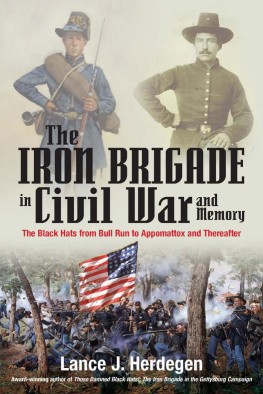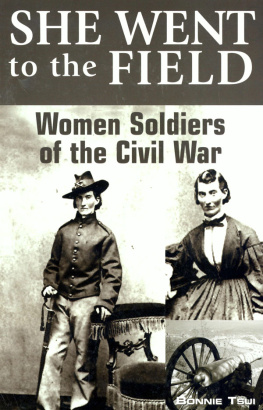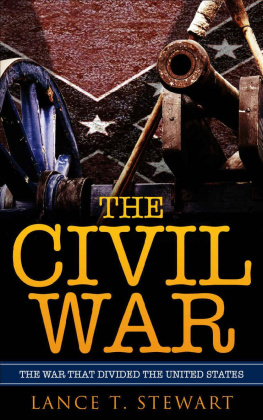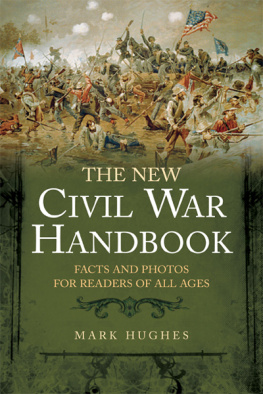Pagebreaks of the print version

Facts and Photos for Readers of All Ages
U NION S OLDIERS
in the American Civil War
Lance J. Herdegen
2018 by Lance J. Herdegen
All rights reserved. No part of this publication may be reproduced, stored in a retrieval system, or transmitted, in any form or by any means, electronic, mechanical, photocopying, recording, or otherwise, without the prior written permission of the publisher.
Library of Congress Cataloging-in-Publication Data
Names: Herdegen, Lance J., author.
Title: Union Soldiers in the American Civil War: Facts and Photos for
Readers of All Ages / by Lance J. Herdegen.
Description: First edition. | El Dorado Hills, California : Savas Beatie LLC,
2018. | Includes bibliographical references and index.
Identifiers: LCCN 2018043002| ISBN 9781611213393 (pbk : alk. paper) | ISBN 9781611213409 (ebk)
Subjects: LCSH: Soldiers--United States--History--19th century. | United
States--History--Civil War, 1861-1865. | United States.
Army--History--Civil War, 1861-1865. | United States. Army--Military
life--History--19th century.
Classification: LCC E607 .H47 2017 | DDC 973.7/41--dc23
LC record available at https://lccn.loc.gov/2017043002
ISBN (print): 978-1-61121-339-3 / ISBN (ebook): 978-1-61121-340-9 / ISBN (mobi): 978-1-61121-340-9
First Edition, First Printing
Savas Beatie LLC
989 Governor Drive, Suite 102
El Dorado Hills, CA 95762
Phone: 916-941-6896 / (web)
Savas Beatie titles are available at special discounts for bulk purchases in the United States by corporations, institutions, and other organizations. For more details, please contact Savas Beatie, P.O. Box 4527, El Dorado Hills, CA 95762, or you may e-mail us at for additional information.
Proudly published, printed, and warehoused in the United States of America.
For Shirley Ann
Bonnie, Lisa, Jill, Jennifer and Nicole
Introduction
M y lifelong interest in the Union soldier began when I was 12, when my father brought home a musket and sword he found while helping a friend clean out a shed. The rifled-musket was an 1861 Colt Special Model, dated 1864. It was still at full-length with three bands, butobviously war surplusthe rifling in the barrel had been partially ground away to make a shotgun for commercial trade.
The weapon completely fascinated me. Being a true son of the Badger state, I had to learn to shoot it. That led me to a local muzzle- loading rifle club, and thenwith a better ordnanceto the marksmanship competitions with Civil War small arms in the North-South Skirmish Association.
The journey, and my growing fascination with the Civil War, also raised lingering questions about the Union soldier who has come to us as simply Billy Yank. From an early age I wondered, Why did so many young men flock to the flag in 1861? What did he eat and how did he get his food? What additional equipment did he carry? What did he look like? Was he tall? How old were Yankee soldiers? What were his chances of being killed or wounded in battle? I was also curious about their general views on the Union itself, and, of course, the institution of slavery.
Reading books raised even more questions: What is a company, or a regiment, brigade, division, or corps? I didnt know, and most books just assumed that I did. What did they do in the winter? What happened to men when they were wounded? The answers, as I eventually learned, could be found in other sourcesbut they were not always quickly at hand, and in some cases, they were not all that easy to find.
Later, I found many of the answers to my own questions, and, of course scores of others, while serving as the Director of The Institute for Civil War Studies at what is now Carroll University in Wisconsin. Other information was researched by the good folks at the Civil War Museum of the Upper Middle West at Kenosha, Wisconsin, a place that should be on the must-visit list of anyone interested in the 1861-65 period. The museum tells a unique and insightful story not always found in other such facilities.
Union Soldiers in the American Civil War (soon to be accompanied by a similar book titled Confederate Soldiers in the American Civil War , by Mark Hughes) is written in the present tense for more immediacy, and is intended as a quick resourcean easy, informative, and engaging reading experience. This book was written for anyone who wants to know more about the Civil War in general, and Union soldiers and sailors in particular.
I am sure you will findas I dothat the soldiers who fought for the Union so long ago were an interesting and varied lot. I am also sure you will come to value your acquaintance with these boys who left home only to be caught up in a war that forever changed them and their beloved nation.
Lance J. Herdegen
Town of Spring Prairie
Walworth County, Wisconsin
Acknowledgments
The writing and research needed to prepare a book appears to be the work of one person. In fact, it is the work of many. Countless handsoften stretching back over a lifetimestir the kettle and influence the final pages. To the following, in no special order, I offer thanks: Daniel Netteshiem, Gary Van Kauwenberg, Paul Johnson, Phil Spaugy, Kim J. Heltemes, Andy Ackeret, Donna Agnelly, with a special nod to my colleagues at The Civil War Museum of the Upper Middle West, Dan Joyce, Gina Radandt, Ruth Joyce, and Doug Dammann. Many others also helpedtoo many to name them all here. Know that I appreciate all everyone has done to make this book possible.
A special thanks and a lifting of a glass of Apple Jack for my friend, editor, and publisher Theodore P. Savas. His efforts, along with the good folks at Savas Beatie, will have a lasting impact on Civil War scholarship for their outstanding books on the 1861-65 era.
And somewhere, across the dark river in a quiet camp where the pet dog of Captain Werner von Bachelle still frolics, I am sure James Patrick Sullivan, Mickey, of Company K, is smiling.
He is Called Billy Yank
T he common Union soldier in the American Civil War is known by many names. The Confederates across the lines call him a Bluebelly (for the color of his uniform) or a Mudsill (a reference to societys lower classes), and even a Lincolnite (for his politics), but the name carried down through the decades is simply Billy Yank.
Statistics kept in 1861 to 1865 give us a composite picture of the typical Union soldier. He is generally about 25 years old, but many Union soldiers are 18 or slightly older. A few are as old as 60. Most are born in America, but many are foreign born. Germany furnished 175,000 men to the war effort, Ireland 150,000, and England 50,000. Billy Yank stands a bit above 5-foot-8, but soldiers from a few states, including Indiana and Iowa, are slightly taller. Of one million men recorded, more than 3,613 are taller than 6-ft., 3 inches. Several stand taller than 7 feet. The average solder weighs 143 pounds, and more than half have dark (black or brown) hair. One percent has gray hair. Almost three-fourths of the soldiers have blue or grey eyes.












